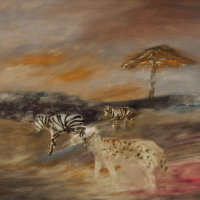34. SIDNEY NOLAN

At Serengeti the great herds in migration are just like the walls of Lascaux come alive These animals have a message for us in that they are unique the message will become fossilized as the species die out. One comes to view them as works which will not be repeated again; the fascination of going to see a zebra or a gazelle is the fascination of discovering a perfected shape.1
In the autumn of 1962, Sidney Nolan and his wife Cynthia spent ten days in the Serengeti National Park, in what is now northern Tanzania. Observing the animals in their natural state, Nolan was struck by their ready-made beauty: they look like new works of art, shining as if theyd just been painted.2 Returning to his London studio, Nolan worked with characteristic bravura and speed. Working in thin washes of oil on hardboard, Nolan smudged in the basic elements of each composition with a nylon stocking, before painting the finer details with a heavily loaded brush.3 His African paintings are marked by their rich colouration, dyed streaky surfaces,4 and a compelling sense of the ephemeral.
This final quality is seen to dramatic effect in Cheetah and Zebra, where the central foreground is filled with the ghostly outline of a cheetah hunting its striped prey. Partially camouflaged, the predators spotted coat is blurred with the act of motion, its limbs fading into the dry ground. As Nolan explained, I feel that theres a kind of painting to be done with animals and natural camouflage that would be, in a sense, a no-painting; there would be a total disappearance of the image but if you stared at it long enough the image would eventually waft up.5
Nolans interest in camouflage and motion picture-like movement was not merely for visual effect. As the writer Andrew Turley recently observed, Nolans paintings of African wildlife are delivered as a form of extinction art.6 There is a note of melancholy attached to his admiration for these animals a prescient concern for their demise at the hands of humankind.
Cheetah and Zebra was first unveiled at Londons Marlborough Gallery in May 1963, at an opening attended by Princess Margaret and Lord Snowdon. By this time, Nolans international reputation had been firmly established, and despite mixed reviews from the British press, it was reported that his African paintings sold, of course, like hot cakes.7
Footnotes:
1. Sidney Nolan, quoted in Rosenthal, T., Sidney Nolan, Thames & Hudson, London, 2002, p.179
2. Ibid.
3. Clark, J., Sidney Nolan: Landscapes & Legends - A Retrospective Exhibition: 1937-1987, International Cultural Corporation of Australia Limited, Sydney, 1987, p.144
4. Gosling, N., Sidney Nolan on Safari, The Observer, London, 12 May 1963, p.28
5. Sidney Nolan, quoted in Rosenthal, T., Sidney Nolan, p.179
6. Sidney Nolans Africa Interview with Andrew Turley and Revd Jonathan Evens, Art Lyst, 3 October 2021 [accessed October 2021]: https://www.artlyst.com/features/sidney-nolans-africa-interview-andrew-turley-revd-jonathan-evens/
7. Boys, L. Roving Reporter of Art: Africa in Vivid Nolancolour, The Bulletin, Sydney, vol.85, no.4357, 24 August 1963, p.32
Catherine Baxendale